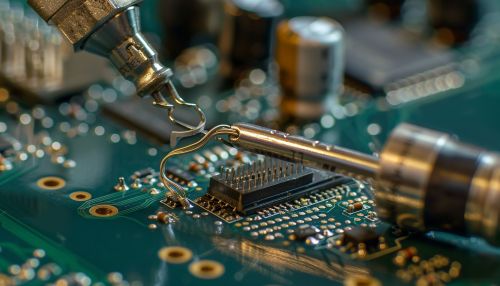Solder: Difference between revisions
No edit summary |
No edit summary |
||
| Line 44: | Line 44: | ||
* [[Electronics manufacturing]] | * [[Electronics manufacturing]] | ||
[[Image:Detail-77947.jpg|thumb|center|A close-up image of a soldering process, showing a soldering iron, solder wire, and a circuit board.]] | [[Image:Detail-77947.jpg|thumb|center|A close-up image of a soldering process, showing a soldering iron, solder wire, and a circuit board.|class=only_on_mobile]] | ||
[[Image:Detail-77948.jpg|thumb|center|A close-up image of a soldering process, showing a soldering iron, solder wire, and a circuit board.|class=only_on_desktop]] | |||
[[Category:Soldering]] | [[Category:Soldering]] | ||
[[Category:Metallurgy]] | [[Category:Metallurgy]] | ||
[[Category:Electronics]] | [[Category:Electronics]] | ||
Latest revision as of 14:49, 8 May 2024
Introduction
Solder is a fusible metal alloy used to create a permanent bond between metal workpieces. Solder is melted in order to adhere to and connect the pieces after cooling, which requires that an alloy suitable for use as solder have a lower melting point than the pieces being joined. The solder should also be resistant to oxidative and corrosive effects that would degrade the joint over time. Solder used in making electrical connections also needs to have favorable electrical characteristics.
History
Soldering has been known and used for thousands of years. The Egyptians and Sumerians were among the first civilizations to utilize the process of soldering. Early soldering was often done with gold and silver alloys. The advent of tin mining in Europe brought a new material into the process, and tin/lead alloys became common.
Types of Solder
There are many types of solder available on the market today, each with its own specific characteristics and applications.
Soft Solder
Soft solder typically contains lead and tin, but can also contain other metals such as silver, copper, and antimony. Soft solder has a relatively low melting point, typically around 190 to 840 degrees Fahrenheit. This type of solder is commonly used in electronics, plumbing, and sheet metal work.
Hard Solder
Hard solder, also known as silver solder, is used for high-temperature applications and in jewelry making. It has a higher melting point than soft solder, typically around 840 to 1450 degrees Fahrenheit. Hard solder is often used in brazing and silver soldering procedures.
Flux Core Solder
Flux core solder contains a center of flux that aids in the soldering process. The flux helps to clean the metal surfaces and prevent oxidation, which can interfere with the soldering process. Flux core solder is commonly used in electronics and other applications where a clean, strong bond is required.
Lead-Free Solder
Lead-free solder is becoming increasingly popular due to health and environmental concerns associated with lead. Lead-free solder often contains tin and copper, but can also contain silver or other metals. The melting point of lead-free solder is typically higher than that of lead-based solder, which can make it more difficult to work with.
Soldering Process
The process of soldering involves heating the solder until it melts and then applying it to the joint that needs to be soldered. The solder is then allowed to cool and harden, forming a strong, permanent bond.
Preparation
Before soldering, the surfaces to be joined must be cleaned and free of any dirt, grease, or oxidation. This can be done using a wire brush or sandpaper, or by applying a chemical cleaner. The soldering iron or gun must also be preheated to the correct temperature before use.
Application
The solder is applied to the joint using a soldering iron or gun. The solder should be heated until it melts and flows freely, but not so hot that it burns or vaporizes. The solder should be applied to the joint, not the soldering iron or gun. The solder will flow towards the heat and fill in the joint.
Cooling and Cleaning
After the solder has been applied and the joint is filled, the solder must be allowed to cool and harden. This can take anywhere from a few seconds to several minutes, depending on the size of the joint and the type of solder used. Once the solder has cooled and hardened, the joint should be cleaned to remove any residual flux or other contaminants.
Safety Considerations
Soldering can be a dangerous activity if proper safety precautions are not taken. The soldering iron or gun can reach temperatures of several hundred degrees Fahrenheit, and the solder itself can cause burns if it comes into contact with skin. Fumes from the solder and flux can also be harmful if inhaled. Therefore, it is important to always wear protective clothing and work in a well-ventilated area when soldering.
Environmental Impact
The use of lead-based solder has been a source of environmental concern due to the toxicity of lead. Many countries have enacted regulations limiting the use of lead-based solder, and lead-free alternatives are becoming increasingly popular. However, the production and disposal of any type of solder can have environmental impacts, and efforts are being made to develop more sustainable practices in the soldering industry.
See Also


